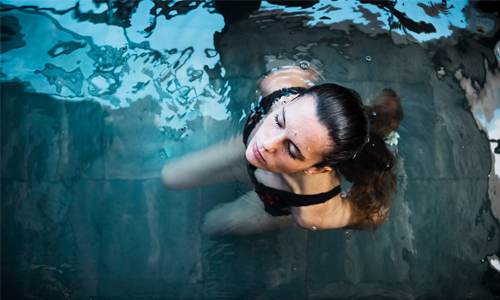You might have a zillion questions in mind regarding ice baths. What exactly is an ice bath? Who can have it? How much time should I spend on it? So on and so forth… We will answer all your questions about these baths in this blog. We will also help you understand the merits and demerits of having them. So let’s begin right away!
What Is an Ice Bath?

An ice bath is a procedure where a person immerses a major part of their body in a tub (or any container) of ice or ice water for a limited time. It is also called, “cold therapy.”
Sportspersons and people involved in intense physical activity usually take such baths after their workout sessions or competitions. They believe that these baths help reduce muscle pain/soreness (after any intense activity) to an extent. The subject of these baths is a highly debated one. Many say they are beneficial, while others think they are dangerous. People react differently to ice baths, depending on their age, body temperature, workout intensity, and tolerance to ice. However, many fitness enthusiasts consider it a fun activity.
What are the benefits of Ice Baths?

Let’s take a look at the benefits of Ice Bath so that you can decide whether it will be beneficial for your body. Such therapy can do the following to your body:
- Helps your body recover faster after exercising/competing in sports
- Leads to better performance. Regular body immersions of athletes in ice have proved that they improve performance
- Reduces inflammation in your body after workouts
- Helps enhance your mood
- Improves sleep by curtailing sleep disorders
- Boosts your immune system
- Minimizes the impacts of heat and humidity on your body
The bath helps you recover faster from workout-induced muscle soreness and injury. Although many sportspersons find cold therapy advantageous, and lots of celebrities also promote these baths, more research is needed in this area. In other words, more studies are needed to confirm their benefits.
Are Ice Baths Good for You?

It depends. If done the right way, cold therapy can be good for you. Time and temperature are critical factors when we consider ice baths. Usually, a 10 to 15-minute dip in 50-59°F cold water is recommended. If the water temperature is too cold, or you stay longer than the recommended time, you can get hypothermia. So you must be highly cautious when you try cold baths/cold therapy.
If you are involved in sports or lots of intense exercises, you can try these baths. Even then, you must consult your doctor/healthcare provider before trying anything new like cold therapy.
From the benefits we have listed in the previous section, you can find out if ice baths are suitable for your body and mind.
Are Ice Baths Dangerous?

They are not dangerous to everyone. However, in case you have high blood pressure or any cardiovascular disease, you must not try ice baths. If you have type 1 or type 2 diabetes, you must be very cautious about such baths. That’s because people with diabetes find it more challenging to maintain their core body temperature if the outside temperature is extreme.
It is dangerous to spend more than 20 minutes in any type of cold therapy because it could lead to shock. Sudden cardiac death is also possible if you spend too much time in ice or ice water. Since exposure to extreme coldness can result in fatal consequences, you must be careful with cold baths.
If you are pregnant or breastfeeding, you must be extra cautious. Some women assume that cold therapy eases pregnancy. However, this is not true in all cases. Therefore, consult your doctor, ask them for advice on the same, and act accordingly.
How Cold Should an Ice Bath Be?

As stated earlier, maintaining the temperature of your tub of ice water is of paramount importance. The range must be 50-59°F (below 15°C) because cold water is considered therapeutic to the human body at this temperature. At this range, you can reap the physical and mental benefits of cold therapy. Risks of health issues at any temperature above this limit are high.
What Happens to the Body During an Ice Bath?

When a part of your body is immersed in ice-cold water, vasoconstriction takes place. In this process, the blood vessels are constricted so that the blood flow to the various parts slows down. Vasoconstriction has its merits and demerits. It can be harmful to individuals who already have decreased blood flow. In such cases, even stroke or cardiac arrest is possible.
If you are a woman who is athletic or interested in daily intense workout sessions, you can learn more about vasoconstriction by talking to a sports medicine specialist.
Have You Heard of the Ice Bucket Challenge?

If you don’t remember what the challenge was, we will describe it now! In July-August 2014, there were activities involving the pouring of a bucket of ice water on people’s heads. Either someone poured it on the person’s head, or it was self-administered. The reason behind the challenge was to make people aware of the ALS (Amyotrophic Lateral Sclerosis) disease and also collect funds for people suffering from the same. The ALS challenge went viral, and many people from the US and UK participated in the event.
Simple Tips for Ice Baths

Follow these tips to get the best out of your baths!
- Start with partial body baths. You can first immerse your feet in a tub of ice. Or, you can begin with your hands, and proceed to the chest.
- Initially, have a 5-minute bath after exercising, and then slowly increase the duration over the weeks.
- Although we say that the maximum duration of a bath must be 20 minutes, it would be wiser to keep it at 10-15 minutes.
- If you have an underlying body condition, stay away from ice baths.
- Don’t wait for an hour or so after a physical activity to have this bath because the sooner, the better.
- If the temperature is too low, keep adding warm water to attain the right temperature. Similarly, if it’s too high, keep adding ice to reach the ideal temperature.
Weigh the Pros and Cons of the Procedure

Yes! Looking at the benefits and drawbacks of the baths is crucial for deciding the further course of action. As mentioned earlier, get your doctor’s consent before you start with an ice bath. And, ensure you don’t exceed the time and temperature of the baths. Just as for food and daily exercise, moderation is key for ice baths!
Leia
Related posts
Women Tips
Privacy Overview
| Cookie | Duration | Description |
|---|---|---|
| cookielawinfo-checkbox-analytics | 11 months | This cookie is set by GDPR Cookie Consent plugin. The cookie is used to store the user consent for the cookies in the category "Analytics". |
| cookielawinfo-checkbox-functional | 11 months | The cookie is set by GDPR cookie consent to record the user consent for the cookies in the category "Functional". |
| cookielawinfo-checkbox-necessary | 11 months | This cookie is set by GDPR Cookie Consent plugin. The cookies is used to store the user consent for the cookies in the category "Necessary". |
| cookielawinfo-checkbox-others | 11 months | This cookie is set by GDPR Cookie Consent plugin. The cookie is used to store the user consent for the cookies in the category "Other. |
| cookielawinfo-checkbox-performance | 11 months | This cookie is set by GDPR Cookie Consent plugin. The cookie is used to store the user consent for the cookies in the category "Performance". |
| viewed_cookie_policy | 11 months | The cookie is set by the GDPR Cookie Consent plugin and is used to store whether or not user has consented to the use of cookies. It does not store any personal data. |

